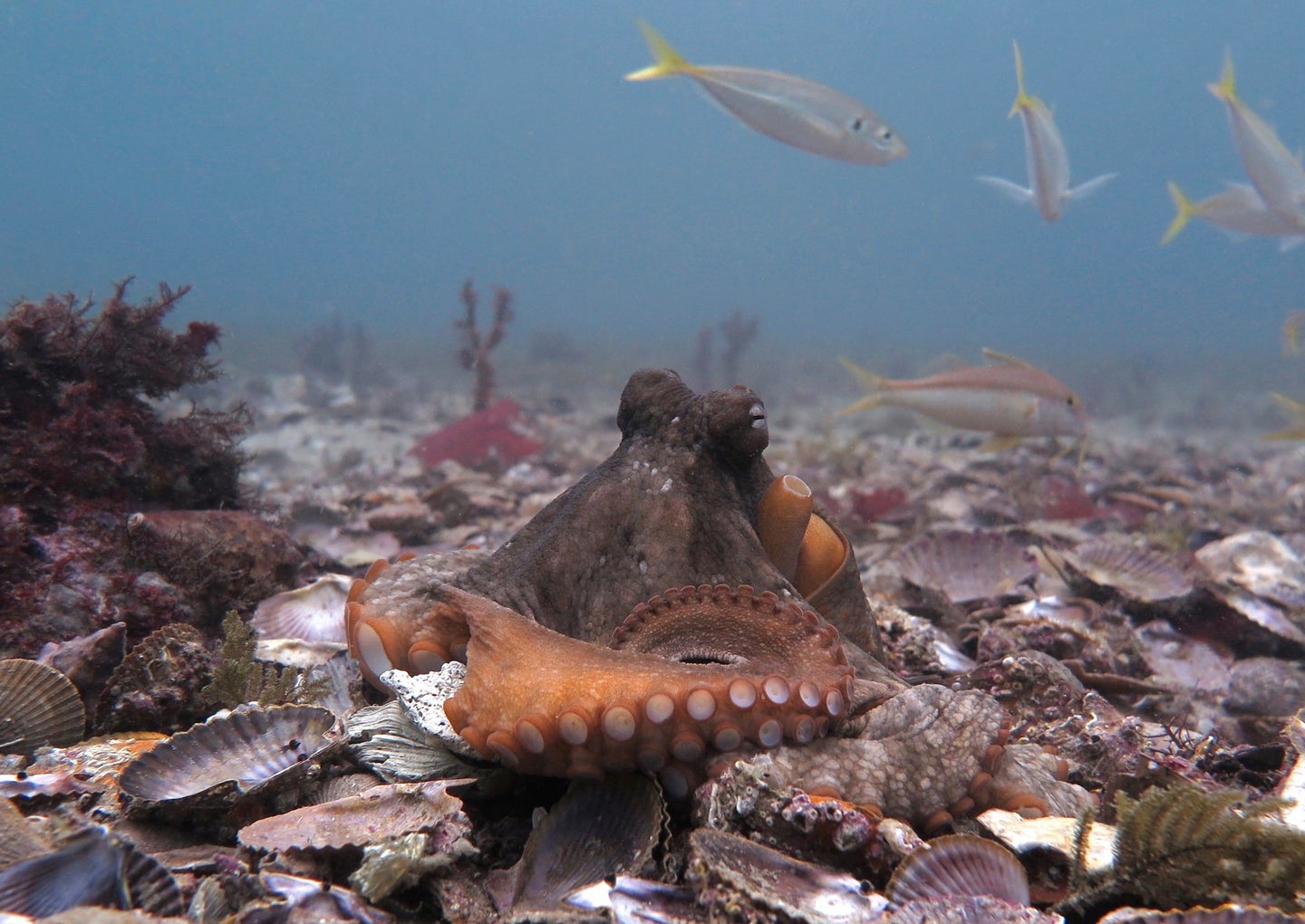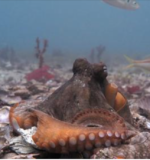The debris-chucking octopuses were caught on camera for the first time in Australia.

Having eight arms can make for some interesting sporting events (just check out the weird history of octopus wresting). But, if the idea of battling it out with a 100-pound, multi-armed sea beast wasn’t scary enough, imagine having eight arms throwing seashells at you. A study published today in the open-access journal PLOS ONE shows octopuses deliberately throwing debris like silt and shells, sometimes directed at other octopuses, for the first time.
In 2015 and 2016, the team of scientists from Australia and the United States used underwater cameras to record the behavior of the gloomy octopus (Octopus tetricus) in Jervis Bay in southeastern Australia. The bay is home to the world’s whitest sand on its beaches, Earth’s smallest penguin species called fairy penguins, marine mammals, and a lot of cephalopods.
“Our study arose from the concentration of octopuses at this site, which was unusual,” study author David Scheel, a marine biology professor from Alaska Pacific University, tells PopSci. “Interactions among octopuses occur very often when there are many animals present, so this location presents the rare opportunity to study behaviors beyond just mating that octopuses bring to bear on interacting with their own kind.”
The team looked at 24 hours of footage from several days and found 102 instances of debris throwing activity in a group of about 10 octopuses. Identifying the assailants individually wasn’t always possible.
After the octopuses gathered grainy silt from the seafloor or shells after eating, they released the projectiles using a tube-shaped structure above its legs that that can eject water called the siphon. The siphon was used to propel the material between their eight arms and through the water.
The projectiles were often thrown several body lengths away, and in order to do this, the octopuses had to move their siphon into an unusual position. This difficulty suggests that the throwing behavior was different than what’s needed for their general movements in the water.
“The throwing of objects that have been oriented by the thrower is a rare animal behavior,” Scheel says. “Doing this under water, even for a short distance, seems especially unusual and quite hard to do, making this an even more striking behavior.”
While both males and females were observed throwing, 66 percent of throws were made by females. About half of the throws happened during or around interactions with other octopuses, such as arm probes or mating attempts. About 17 percent of throws observed hit other octopuses, which isn’t too bad for an animal that lives under water and lacks opposable thumbs or rotator cuffs.
In addition to their cool arms, octopuses can change their skin coloration, with dark colors generally associated with aggression. The team found that darker hued octopuses could throw more forcefully and were even more likely to hit another octopus.
But the octopuses hit by thrown material were not completely helpless. They often altered their behavior by ducking or raising their arms in the direction of the thrower.
“To our knowledge, throwing by octopuses has not been reported before, so to find them throwing at other octopuses is new. Generally, octopuses are normally solitary animals. This appears to be one more way in which they try to manage interacting with each other,” says Scheel.
While the authors say it is difficult to determine the exact intention of this shell chucking, the observations suggest that octopuses are capable of targeted throws towards other individuals in some circumstances. This is a complicated behavior that has only been observed previously in some non-human animals like chimpanzees, capuchin monkeys, elephants, and birds.
“Wild octopuses project various kinds of material through the water in jet-propelled ‘throws,’ and these throws sometimes hit other octopuses,” the authors said in a joint statement. “There is some evidence that some of these throws that hit others are targeted, and play a social role.”








 Photographer Finds Locations Of 1960s Postcards To See How They Look Today, And The Difference Is Unbelievable
Photographer Finds Locations Of 1960s Postcards To See How They Look Today, And The Difference Is Unbelievable  Hij zet 3 IKEA kastjes tegen elkaar aan en maakt dit voor zijn vrouw…Wat een gaaf resultaat!!
Hij zet 3 IKEA kastjes tegen elkaar aan en maakt dit voor zijn vrouw…Wat een gaaf resultaat!!  Scientists Discover 512-Year-Old Shark, Which Would Be The Oldest Living Vertebrate On The Planet
Scientists Discover 512-Year-Old Shark, Which Would Be The Oldest Living Vertebrate On The Planet  Hus til salg er kun 22 kvadratmeter – men vent til du ser det indvendigt
Hus til salg er kun 22 kvadratmeter – men vent til du ser det indvendigt  Superknepet – så blir snuskiga ugnsformen som ny igen!
Superknepet – så blir snuskiga ugnsformen som ny igen!  Meteorite That Recently Fell in Somalia Turns Out to Contain Two Minerals Never Before Seen on Earth
Meteorite That Recently Fell in Somalia Turns Out to Contain Two Minerals Never Before Seen on Earth  Nearly Frozen Waves Captured On Camera By Nantucket Photographer
Nearly Frozen Waves Captured On Camera By Nantucket Photographer  It’s Official: Astronomers Have Discovered another Earth
It’s Official: Astronomers Have Discovered another Earth 
iljitf
0modho
66ylkq
15v8ce
pgu690
72u51o
590×52